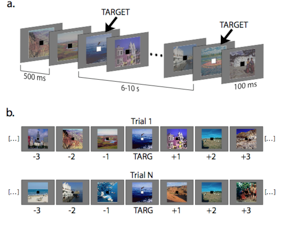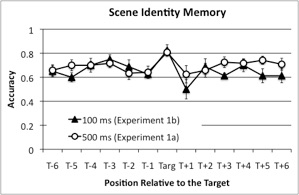
Research
Why do drivers sometimes miss red lights and radiologists cancerous tumors? How can we reduce human errors? Our research examines attention – the brain mechanism that allows us to focus on important tasks. We showed that although attention is limited, people are highly adept at learning to attend to important aspects of their environment. This ability, preserved in older adults, young children, and individuals with neurological disorders, may facilitate tasks like driving and cancer diagnosis.
Recent Research
Autism and Attention
Are attentional deficits the root cause of autism spectrum disorders (ASD)? Several theories have proposed that early deficits in orienting and disengaging attention, a propensity to attend to local details rather than the global gist, and a deficit in executive control may have cascading impact on one's social and communicative development. Alternatively, autism may be primarily a domain-specific condition that impact social and communication skills, leaving intact nonsocial functions such as attention. The following papers represent our attempt at characterizing the attention function in children with high-functioning ASD.
-
Jiang YV, Capistrano CG, Esler AN, Swallow KM (2013). Directing attention based on incidental learning in children with autism spectrum disorder. Neuropsychology, 27(2), 161-169.
-
Koldewyn K, Jiang YV, Weigelt S, Kanwisher N (2013). Global/local processing in autism: Not a disability, but a disinclination. Journal of Autism & Developmental Disorders.
-
Koldewyn K, Weigelt S, Kanwisher N, Jiang Y (2013). Multiple object tracking in autism spectrum disorders. Journal of Autism & Developmental Disorders, 43(6), 1394-1405.
-
Fischer J, Koldewyn K, Jiang YV, Kanwisher N (in press). Unimpaired attentional disengagement and social orienting in children with autism. Clinical Psychological Science.
Is spatial attention viewer-centered or environment-centered?
What is the nature of the spatial representation underlying visual attention? For example, when an online ad captures your attention, is the attended location coded relative to you (e.g., in the upper visual field) or relative to the external environment (e.g., on the right side of the screen)? In a series of studies we examined the spatial reference frame that supports one type of visual attention: incidentally learned attention. We showed that implicitly learned attention is referenced relative to the viewer. In fact, environmentally-stable visual statistics cannot be learned unless they are consistent relative to the viewer's perspective. These studies provide some of the strongest evidence for the idea that one component of spatial attention is viewer centered, and that there are substantial limits in our ability to acquire visual statistical learning.
-
Jiang YV, Swallow KM (2013). Spatial reference frame of incidentally learned attention. Cognition, 126, 378-390.

- Jiang YV, Swallow KM, Capistrano CG (2013). Visual search and location probability learning from variable perspectives. Journal of Vision, 13(6): 13.
-
Jiang YV, Swallow KM, Sun L (2015). Egocentric coding of space for incidentally learned attention: Effects of scene context and task instructions. Journal of Experimental Psychology: Learning, Memory, & Cognition
Dual-task processing and the attentional boost effect
Hand-held devices and social media have made multitasking customary in modern life. Yet the human brain is severely limited in capacity. A critical problem in cognitive science is to understand the nature of dual-task interaction: Under which conditions do two tasks compete for cognitive resources, and is it possible for one task to piggyback on the other such that performance in both tasks improves at the same time?
Extensive laboratory research has shown that dual-task interference is ubiquitous. Such interference is captured by the attention operation characteristic (Kinchla, 1992), which depicts the processing of two concurrent tasks as a trade-off. Increasing processing in one task impairs, or at best leaves intact, processing in the other.
In a series of studies, Khena Swallow and I have observed a striking exception to the ubiquitous finding of dual-task interference. We showed that under some circumstances, increasing attention to one task can enhance processing of another. The following studies represent our attempt at characterizing the attentional boost effect and at reconciling the attentional boost with dual-task interference.
-
Swallow, K.M., & Jiang, Y.V. (2010). The Attentional Boost Effect: Transient Increases in Attention to One Task Enhance Performance in a Second Task. Cognition, 115(1), 118-132.


The neural signature of the attentional boost effect is highly unique. When participants monitor a stream of beeps for target tones, activity in the task network increases when target tones are detected, compared with when nontarget tones are rejected. This increase also occurs in the primary auditory cortex. Surprisingly, instead of pulling resources away from the visual cortex, detecting auditory targets increases neural activity in early visual areas. Contrary to standard signatures of visuospatial attention, the target-mediated boost is stronger in V1 than V2 and V3 and absent in higher visual areas. In addition, it is spatially nonspecific.
-
Swallow KM, Makovski T, Jiang &V (2012). The selection of events in time enhances activity throughout early visual cortex. Journal of Neurophysiology, 108, 3239-3252.
-
Swallow KM & Jiang YV (2013). Attentional load and attentional boost: A review of data and theory. Frontiers in Psychology, 4, 274.
-
Toh, Y.N., Lee, V.G. (2022). Response, rather than target detection, triggers the attentional boost effect in visual search. Journal of Experimental Psychology: Learning, Memory, & Cognition.
How do concerns about COVID-19 affect attention?
The emergence of SARS-CoV-2 suddenly and profoundly altered the daily lives, workplace operations, and internal experiences of many people. With increasing concerns and shifting priorities, many feel preoccupied with thoughts about the physical and financial threats the virus and the resulting economic upheaval may pose. The elevated concerns may draw attention away from important stimuli in daily tasks, such as driving, schooling, and workplace responsibilities. Might preoccupation with the physical and financial threats of COVID-19 interfere with performance on tasks requiring attention?
In two studies, we explored how concerns about COVID-19 affect sustained attention, working memory, perceptual attention, and cognitive control. Our studies found, surprisingly, that young adults are largely able to suppress their COVID concerns. However, mind wandering during the attention tasks is associated with worse performance.
- Jun, J., Toh, Y.N., Sisk, C.A., Remington, R.W., Lee, V.G. (2021). Do concerns about COVID-19 impair sustained attention? Cognitive Research: Principles and Implications, 6: 41.
- Sisk, C.A., Toh, Y.N., Jun, J., Remington, R.W., Lee, VG (2022). Impact of active and latent concerns about COVID-19 on attention. Cognitive Research: Principles and Implications, 7(1):48.
What causes human errors in cognitive tasks?
At the core of human errors is our extremely limited ability to attend to multiple tasks or stimuli at once. Our studies have elucidated the nature of capacity limits in attention and working memory, as well as the brain basis for attention.
- Jiang Y, Kanwisher N (2003). Common neural mechanisms for response selection and perceptual selection. Journal of Cognitive Neuroscience, 15, 1095-1110
- Jiang Y, Saxe R, Kanwisher N (2004). fMRI provides new constraints on theories of the Psychological Refractory Period. Psychological Science, 15, 390-396.
- Jiang Y, Olson IR, Chun MM (2000). Organization of visual short-term memory. Journal of Experimental Psychology: Learning, Memory, & Cognition, 26, 683-702.
- Makovski T, Sussman R, Jiang YV (2008). Orienting attention in visual working memory reduces interference from memory probes. Journal of Experimental Psychology: Learning, Memory, & Cognition, 34(2), 369-380.
- Vickery TJ, Jiang YV (2009). Inferior parietal lobule supports decision-making under uncertainty in humans. Cerebral Cortex, 19(4), 916-925.
- Shim WM, Alvarez GA, Vickery TJ, Jiang YV (2010). The number of attentional foci and their precision are dissociated in the posterior parietal cortex. Cerebral Cortex, 20, 1341-1349.
- Jun, J., Lee, V.G. (2021). Perceptual and response factors in the gradual onset continuous performance task. Attention, Perception, & Psychophysics, 83(7), 3008-3023.
Implicit learning as a compensatory mechanism for attentional limits
Most of us don’t actively tally where traffic lights are – we drive by dozens of them every day; in Minnesota, they almost always hang in the middle of the road above the traffic lanes. The consistency of their locations leads us to automatically attend to that location while driving, often without thinking about it. The significance of this habit of attention emerges when we travel out of state and suddenly start missing traffic lights placed on the right side of the road! For two decades, research in our lab has led the field on implicitly guided attention. This work has fundamentally changed theories of attention, introducing habitual attention as an important new concept in understanding this cognitive mechanism (Jiang & Sisk, 2019).
- Chun MM, Jiang Y (1998). Contextual cueing: Implicit learning and memory of visual context guides spatial attention. Cognitive Psychology, 36, 28-71.
- Jiang, Y.V. (2018). Habitual versus goal-driven attention. Cortex, 102, 107-120.
- Jiang, Y.V., Sisk, C.A. (2019). Habit-like attention. Current Opinion in Psychology, 29, 65-70.
- Addleman, D.A., Jiang, Y.V. (2019). Experience-driven auditory attention. Trends in Cognitive Sciences, 23, 927-937.
- Sisk, C.A., Remington, R.W., Jiang, Y.V. (2019). Mechanisms of contextual cueing: A tutorial review. Attention, Perception, & Psychophysics, 81, 2571-2589.
Medical Image Perception
Errors in medical diagnosis are surprisingly common. A subset of the errors are attributable to perceptual and attentional errors, where the radiologist or pathologist fails to "see" a tumor that is identifiable when pointed out. Understanding such perceptual and attentional errors are important for improving diagnostic accuracy.
- Sha, L.Z., Remington, R.W., Jiang, Y.V. (2019). Statistical learning of anomalous regions in complex faux X-ray images does not transfer between detection and discrimination. Cognitive Research: Principles and Implications, 3(1):48.
- Hebert, C.R., Sha, L.Z., Remington, R.W., Jiang, Y.V. (2020). Redundancy gain in visual search of simulated X-ray images. Attention, Perception, & Psychophysics, 82, 1669-1681.
- Sha, L.Z., Toh, Y.N., Remington, R.W., Jiang, Y.V. (2020). Perceptual learning in the identification of lung cancer in chest radiographs. Cognitive Research: Principles and Implications, 5(1): 4.
- Trevino, M., Birdsong, G., … Jiang, Y.V., …Wolfe, J.M. (2021). Advancing research on medical image perception by strengthening multidisciplinary collaboration. JNCI Cancer Spectrum, pkab099, https://doi.org/10.1093/jncics/pkab099.